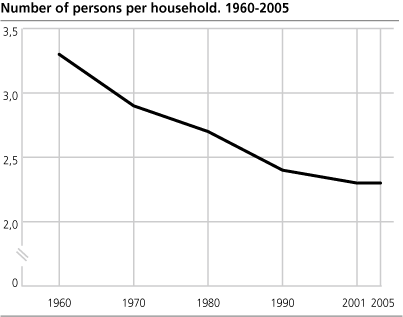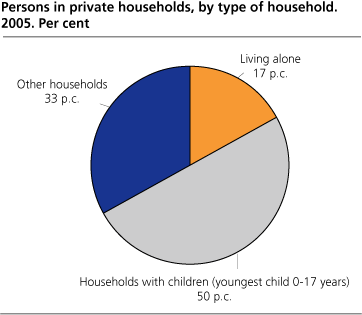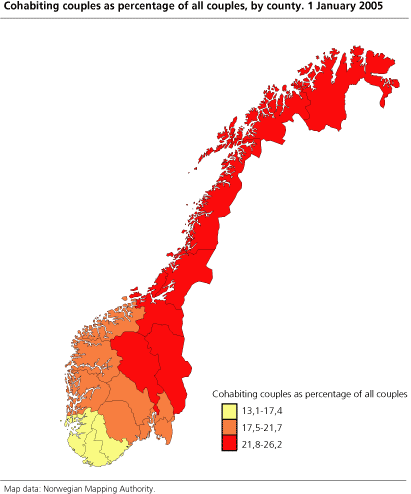Content
Published:
This is an archived release.
Smaller households in Norway
The long-term trend with increasing number of small households continues. At the same time there are large regional variations in the distribution of the population in different types of households.
On 1 January 2005 the average household size was 2.3 persons, against 2.4 in The Population and Housing Census 1990. As a comparison an average household consisted of 2.7 persons in 1980 and 3.3 persons in 1960. These are some of the main results from the new register-based statistics on families and households.
|
The statistics is based on legal resident address on 1 January 2005. This means that unmarried students registered at their parents' address, are regarded as members of the household of their parents. The figures for cohabiting couples comprise cohabitant of opposite sex only. |
Small households in cities and remote areas
Oslo had by far the largest portion of small households and fewer large households compared with other parts of the country. Oslo had 1.9 persons per household. Sogn og Fjordane had 2.5 persons per household and was the county with the largest average household size.
The largest households are mainly found in Southern and Western Norway, and also in municipalities in the commuting areas around the larger cities. 46 of the 50 municipalities with the highest number of persons per household were found in Southern and Western Norway.
The number of small households is highest in central urban municipalities and in remote areas. In many municipalities in Northern Norway and in large areas in the county Hedmark the average household size is small.
17 per cent of the population lived alone
In Norway close to 770 000 persons lived alone on 1 January 2005, 17 per cent of the population. Households consisting of one person made up 38 per cent of all households, an increase from 34 per cent in 1990 and 28 per cent in 1980. Persons living alone are mainly found in remote areas and in the large cities, especially in the central parts of the cities. In the municipalities surrounding the large cities relatively few people are living alone.
Large variations in Oslo
Oslo is the municipality with most persons living alone. More than one fourth of the population lived alone, and more than half of all the households in Oslo consisted of one person. There were, however, large differences between parts of the city. In the inner city approximately two thirds of the households consisted of people living alone. On the opposite side we find the urban district Søndre Nordstrand with only every third household consisting of one person.
Over 60 per cent lived as couples
Among the country's 3.5 million persons aged 18 and above, 60 per cent lived as couples. Couples includes in this context persons who are married, living as registered partners or as cohabitant sand were registered as living in the same dwelling. There are large regional differences. In Oslo nearly half of the population did not live as couples. In the neighbouring county of Akershus the figure is 36 per cent, which is the lowest in Norway. A large portion of the couples in the Oslo/Akershus area seems to have chosen to settle in Akershus. In the Oslo/Akershus region 43 per cent did not live as couples.
79 per cent of the couples are married, including registered partners, and 21 per cent are cohabiting couples. Living as cohabitants is a relatively new phenomenon. Furthermore, many couples have been living together as cohabitants before getting married. Therefore relatively many cohabiting couples are young people. Of all the couples aged between 18 and 29 years, 60 per cent are cohabiting couples. For the age group 30-44 years, 69 per cent of the couples are married.
Most cohabiting couples in Oslo and in the northern counties
Oslo, Hedmark and Oppland, as well as the counties in Trøndelag and Northern Norway have the highest portion of cohabiting couples. Finnmark was the top of the rank with 26 per cent. Vest-Agder was lowest with 13 per cent.
Marriages are most common in the coastal counties from Vestfold to Møre og Romsdal, and in Østfold. Six per cent of the households consisted of mother or father with one or more children - nine out of ten were mothers. Finnmark is on top with eight per cent of the households in this category.
|
The present statistics on families and households are based on a more comprehensive data and new methods of data processing. Due to incomplete input data it has been necessary to edit and adjust the data used. Still the figures published are somewhat less accurate than the corresponding figures from the Population and Housing Census 2001, where additional information from census forms was used. Adjustments for households and persons are conducted as separate procedures. This means that figures for households and persons in some tables are not fully consistent. Figures from the present statistics are generally well comparable with corresponding figures from Census 2001. However, in assessing changes from 2001 to 2005, the accuracy problems mentioned above must be taken into consideration. The former family statistics published up till 1 January 2005 is based on less comprehensive data. This statistics has comprised fewer types of families than the present statistics. When comparing family statistics based on the former and the present method, one should be aware of deviations even for groups included in both statistics, for instance married couples with and without children. For more information on quality and comparability, see About the statistics. |
Tables:
- Table 1 Population by, sex, age and type of household. 1 January 2005
- Table 2 Private households and persons per private household, by county. 1960, 1970, 1980, 1990, 2001 and 2005
- Table 3 Private households, by type of household. 1980, 1990, 2001 and 2005. Number and per cent
- Table 4 Private households and persons in private households, by size of household, county, municipality and urban district. 1 January 2005. Per cent
- Table 5 Private households, by type of household, county, municipality and urban district. 1 January 2005
- Table 6 Private households, by type of household, county, municipality and urban district. 1 January 2005. Per cent
- Table 7 Private households and persons in private households, by type of household. 1 January 2005. Numbers and per cent
- Table 8 Persons in private households, by type of household, county, municipality and urban district. 1 January 2005. Per cent
- Table 9 Families, by type of family, county, municipality and urban district. 1 January 2005
- Table 10 Families with children 0-17 years, by county, type of family and number of children. 1 January 2005
- Table 11 Persons in private households, by sex, cohabitation arrangements and age. 1 January 2005
- Table 12 Couples and persons in couples with and without children in private households, by cohabitation arrangements, number of children in the family and age. 1 January 2005
- Table 13 Couples with and without children in private households, by cohabitation arrangements, county, municipality and urban district. 1 January 2005. Per cent
- Table 14 Persons 18 years and over in private households. Percentage living/not living as couples, by age, county, municipality and urban district. 1 January 2005. Per cent
Contact
-
Statistics Norway's Information Centre
E-mail: informasjon@ssb.no
tel.: (+47) 21 09 46 42
-
Espen Andersen
E-mail: espen.andersen@ssb.no
tel.: (+47) 92 61 00 46
-
Ane Margrete Tømmerås
E-mail: ane.tommeras@ssb.no
tel.: (+47) 91 99 29 62
-
Oppdrag befolkningsstatistikk
E-mail: befolkning@ssb.no



